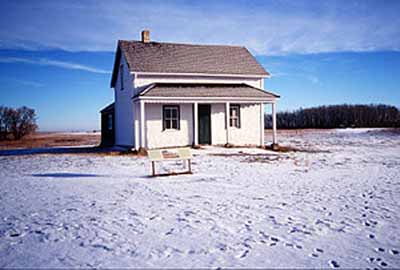Former Jean Caron Sr. House
Recognized Federal Heritage Building
Batoche, Saskatchewan

General view
© Parks Canada Agency / Agence Parcs Canada, I. Wilson, 2002.
Address :
Batoche, Saskatchewan
Recognition Statute:
Treasury Board Policy on Management of Real Property
Designation Date:
1987-11-26
Dates:
-
1890 to 1890
(Construction)
Custodian:
Parks Canada
FHBRO Report Reference:
86-81
DFRP Number:
14442 00
Description of Historic Place
The Former Jean Caron Sr. House is located at the south end of Batoche National Historic Site. It is a simple, rectangular cottage with an end-facing gable roof, a three bay entrance façade and a central door flanked by two windows. A hipped roof verandah extends the full length of the front elevation. The designation is confined to the footprint of the building.
Heritage Value
The Former Jean Caron Sr. House is a Recognized Federal Heritage Building because of its historical associations, and its architectural and environmental values.
Historical Value:
The Former Jean Caron Sr. House is closely associated with the cultural heritage of the Métis population and with the reconstruction of the Métis community after the Rebellion of 1885. It is one of the few surviving structures from the earliest phase of this reconstruction, and because of its documentary value is a rare example of a typical, rural vernacular Métis house, important to the development of the community of Batoche.
Architectural Value:
The Former Jean Caron Sr. House is valued for its good, simple aesthetic, which is typical of rural Métis construction, and based on local Métis vernacular tradition. The building exhibits good functional design, typical of rural Métis houses in Saskatchewan. The house was constructed using indigenous skills and locally available materials, rough-hewn horizontal logs, dovetail joints at the corners, and both the early covering of twig-lath and mud and the later wood siding. These construction techniques illustrate very good crafts and materials.
Environmental Value:
The Former Jean Caron Sr. House is compatible with the historic character of Batoche National Historic Site. It is a familiar landmark to staff and visitors at the site.
Sources:
Shannon Ricketts, Six Buildings in the Batoche National Historic Park, Batoche, Saskatchewan, Federal Heritage Buildings Review Office Report 86-081.
Former Jean Caron Sr. House, Batoche National historic Site (Lot 52), Batoche Saskatchewan, Heritage Character Statement 86-081.
Character-Defining Elements
The character-defining elements of the Former Jean Caron Sr. House should be respected, for example:
Its good aesthetic and simple, functional design and very good crafts and materials, as evidenced in:
The simple, rectangular form and one-and-a-half storey massing of the functional structure; The main, three-bay façade with a central door and two flanking windows; The hipped-roof verandah that extends the full length of the front elevation; The walls constructed of locally available materials such as rough-hewn horizontal logs, dovetail joined at the corners, and both the early covering of twig-lath and mud, and the later wood siding.
The manner in which the Former Jean Caron Sr. House is compatible with the historic character of its Batoche National Historic Site setting and is a familiar local landmark, as evidenced by:
Its overall design and materials that harmonize with the historic setting; Its role as an important component of the surviving structures at the Batoche National Historic Site complex that makes it familiar to locals and visitors.
Heritage Character Statement
Disclaimer -
The heritage character statement was developed by FHBRO to explain the reasons for the designation of a federal heritage building and what it is about the building that makes it significant (the heritage character). It is a key reference document for anyone involved in planning interventions to federal heritage buildings and is used by FHBRO in their review of interventions.
The house was constructed ca. 1890 by farmer and carpenter Jean Caron Sr. Lots 52 and 53 (including the house) were acquired by the federal government in the 1970s. The building is now a part of Batoche National Historic Site. Environment Canada is custodian. See FHBRO Building Report 86-81.
Reason for Designation
The Caron House was designated Recognized because of its associations with the reconstruction of the Metis community after the Rebellion of 1885 and because it is one of the very few surviving structures from the earliest phase of this reconstruction, and because of its documentary value as a rare example of a typical, rural vernacular Metis house.
Character Defining Elements
The designation applies to the entirety of the form and fabric of the building that relates to the period and evolution of its use as the residence of a Metis family.
The value of the building resides in its form as an end-facing gable with additions, and the composition of its main façade consisting of a central door and two flanking small windows, typical of its type. The building's construction is based on the local Metis vernacular tradition - indigenous skills and locally available materials, consisting of rough-hewn, horizontal logs, dovetail joined at the corners, and both the early covering of twig-lath and mud, and the later wood siding. These should be retained and carefully protected. The later additions to the original house reflect the minor changes in the way of life of the occupants. These should be retained and maintained.
Given the value of the Caron House as a social and cultural document, any intervention should have the least possible impact on its form and fabric.